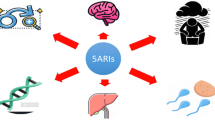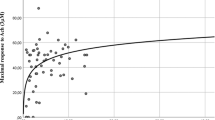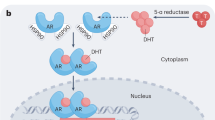Abstract
Testosterone is the most abundant androgen in serum. Intracellularly, testosterone is converted to dihydrotestosterone, the preferred ligand for androgen receptor transactivation, by the enzyme 5α-reductase. Three 5α-reductase isozymes have been discovered and they are expressed ubiquitously in human tissues. Testosterone and dihydrotestosterone have different but complimentary functions. Dihydrotestosterone has 2–5 times higher binding affinity for the androgen receptor than testosterone, and 10-fold higher potency of inducing androgen receptor signaling than testosterone. The role of dihydrotestosterone was discovered after the description of 5α-reductase type 2 deficiency in 1974, where affected males have normal internal but ambiguous external genitalia. Neither BPH nor prostate cancer has been reported in these patients. Currently, two 5α-reductase inhibitors are available for clinical use. This review will discuss the important clinical trials of 5α-reductase inhibitors in the treatment of benign prostatic diseases.
This is a preview of subscription content, access via your institution
Access options
Subscribe to this journal
Receive 4 print issues and online access
$259.00 per year
only $64.75 per issue
Buy this article
- Purchase on Springer Link
- Instant access to full article PDF
Prices may be subject to local taxes which are calculated during checkout
Similar content being viewed by others
References
Imperato-McGinley J, Zhu Y . Androgens and male physiology – The syndrome of 5α-reductase-2 deficiency. Mol Cell Endocrinol 2002; 198: 51–59.
Siiteri P, Wilson J . Testosterone formationand metabolism during male sexual differentiationin the human embryo. J Clin Endocrinol Metab 1974; 38: 113–125.
Russell DW, Wilson JD . Steroid 5a-reductase: two genes/two enzymes. Ann Rev Biochem 1994; 63: 25–61.
Cantagril V, Lefeber D, Ng B, Guan Z, Silhavy J, Bielas S et al. SRD5A3 is required for converting polyprenol to dolichol and is mutated in a congenital glycosylation disorder. Cell 2010; 142: 203–217.
Saartok T, Dahlberg E, Gustafsson JA . Relative binding affinity of anabolic-androgenic steroids: comparison of the binding to the androgen receptors in skeletal muscle and in prostate, as well as to sex hormone-binding globulin. Endocrinology 1984; 114: 2100–2106.
Ciloti A, Danza D, Serio M . Clinical applications of 5α-reductase inhibitors. J Endocrinol Invest 2001; 24: 199–203.
Imperato-McGinley J, Guerrero L, Gautier T, Peterson RE . Steroid 5α-reductase deficiency in man: an inherited form of male pseudohermaphroditism. Science 1974; 186: 1213–1215.
Zhu Y, Sun G . 5α-reductase isozymes in the prostate. J Med Sci 2005; 25: 1–12.
Aggarwal S, Thareja S, Verma A, Bhardwaj T, Kumar M . An overview on 5α reductase inhibitors. Steroids 2010; 75: 109–153.
Drake L, Hordinsky M, Fiedler V, Swinehart J, Unger WP, Cotterill PC . The effects of finasteride on scalp skin and serum androgen levels in men with androgenetic alopecia. J Am Acad Dermatol 1999; 41: 550–554.
Span PN, Voller MC, Smals AG, Sweep F, Schalken J, Fenely M et al. Selectivity of finasteride as an in vivo inhibitor of 5alpha-reductase isozyme enzymatic activity in the human prostate. J Urol 1999; 161: 332–337.
Clark RV, Hermann DJ, Cunningham GR, Wilson TH, Morrill BB, Hobbs S . Marked suppression of dihydrotestosterone in men with benign prostatic hyperplasia by dutasteride, a dual 5-alpha-reductase inhibitor. J Clin Endocrinol Metab 2004; 89: 2179–2184.
Andriole G, Humphrey P, Ray P, Gleave M, Trachtenburg J, Thomas L et al. Effect of the dual 5α-reductase inhibitor dutasteride on markers of tumor regression in prostate cancer. J Urol 2004; 172: 915–919.
Gleave M, Qian J, Andreou M, Pommerville P, Chin J, Casey R et al. The effects of the dual 5alpha-reductase inhibitor dutasteride on localized prostate cancer-Results from a 4 month pre-radical prostatectomy study. Prostate 2006; 66: 1674–1685.
Yamana K, Labrie F, Luu-The V . Human type 3 5α-reductase is expressed in peripheral tissues at higher levels than types 1 and 2 and its activity is potently inhibited finasteride and dutasteride. Horm Mol Biol Clin Invest 2010; 2: 293–299.
Gormley G, Stoner E, Bruskewitz R, Imperato-McGinely J, Walsh P, McConnell J et al. The effect of finasteride in men with benign prostatic hyperplasia. NEJM 1992; 327: 1185–1191.
Guess HA, Gormley GJ, Stoner E, Oesterling JE . The effect of finasteride on prostate specific antigen: review of available data. J Urol 1996; 155: 3.
Guess HA, Heyse JF, Gormley GJ, Stoner E, Oesterling JE . Effect of finasteride on serum PSA concentration in men with benign prostatic hyperplasia. Results from the North American phase III clinical trial. Urol Clin North Am 20; 627: 1993.
Andriole GL, Guess HA, Epstein JI, Wise H, Kadmon D, Crawford ED et al. Treatment with finasteride preserves usefulness of prostate-specific antigen in the detection of prostate cancer: results of a randomized, double-blind, placebo-controlled clinical trial. PLESS Study Group. Proscar Long-Term Efficacy and Safety Study. Urology 52; 195: 1998.
Roehrborn C, Boyle P, Nickel J, Hoefner K, Andriole G . Efficacy and safety of a dual inhibitor of 5alpha-reductase types 1 and 2 (dutasteride) in men with benign prostate hyperplasia. Urology 2002; 60: 434–441.
McConnell J, Bruskewitz R, Walsh P, Andriole G, Lieber M, Holtgrewe L et al. The effect of finasteride on the risk of acute urinary retention and the need for surgical treatment among men with benign prostate hyperplasia. N Eng J Med 1998; 338: 557–563.
Nickel J, Gilling P, Tammela T, Morril B, Wilson T, Rittmaster R . Comparison of dutasteride and finasteride for treating benign prostate hyperplasia: the enlarged prostate international comparator study (EPICS). BJU Int 2011; 108: 388–394.
Thompson I, Goodman P, Tangen C, Lucia MS, Miller GJ, Ford LG et al. The influence of finasteride on the development of prostate cancer. N Eng J Med 2003; 349: 215–224.
Andriole G, Bostwick D, Brawley O, Gomella OW, Marberger M, Montorsi F et al. Effect of dutasteride on the risk of prostate cancer. N Engl J Med 2010; 362: 1192–1202.
Marks L, Andriole G, Fitzpatrick J, Schulman C, Roehrborn C . The interpretation of serum prostate specific antigen in men receiving 5α-reductase inhibitors: a review and clinical recommendations. J Urol 2006; 176: 868–874.
Brawer M, Lin D, Wiliford W, Jones K, Lepor H . The effect of finasteride and/or terazosin on serum PSA: results of VA cooperative study #359. Prostate 1999; 39: 234–239.
Nickel J . BPH: costs and treatment outcomes. Am J Manag Care 2006; 12 (Suppl 5): s141–s148.
DiSantostefano R, Biddle A, Lavelle J . The long-term effectiveness of treatments for benign prostatic hyperplasia. Pharmacoeconomics 2006; 24: 171–191.
Roehrborn C, Marks L, Harkaway R . Enlarged prostate: a landmark national survey of its prevalence and impact on US men and their partners. Prostate Cancer Prostatic Dis 2006; 9: 30–34.
Lehle C, Radvanyi F, Gil Diez de Medina S, Ouafik L, Gerard H, Chopin D et al. Differences in steroid 5alpha-reductase iso-enzymes expression between normal and pathological human prostate tissue. J Steroid Biochem Mol Biol 1999; 68: 189–195.
Habib F, Ross M, Bayne C, Grigor K, Buck A, Bollina P et al. The localization and expression of 5α-reductase types 1 and 2 mRNAs in human hyperplastic prostate and in prostate primary cultures. J Endocrin 1998; 156): 509–517.
Jacobsen SJ, Girman CJ, Guess HA, Rhodes T, Oesterling J, Lieber M . Natural history of prostatism: longitudinal changes in voiding symptoms in community dwelling men. J Urol 1996; 155: 595–600.
Roberts RO, Jacobsen SJ, Jacobsen D, Rhodes T, Girman C, Lieber M . Longitudinal changes in peak urinary flow rates in a community based cohort. J Urol 2000; 163: 107–113.
Fitzpatrick JM . The natural history of benign prostatic hyperplasia. BJU Int 2006; 97 (Suppl 2): 3–6.
Jacobsen SJ, Jacobson DJ, Girman CJ, Roberts RO, Rhodes T, Guess HA et al. Natural history of prostatism: risk factors for acute urinary retention. J Urol 1997; 158: 481–487.
Kolman C, Girman CJ, Jacobsen SJ, Lieber M . Distribution of post-void residual urine in randomly selected men. J Urol 1999; 161: 122–127.
Roehrborn C . Definition of at risk patients: baseline variables. BJU Int 2006; 97 (Suppl 2): 7–11.
McConnell JD, Roehrborn CG, Bautista OM, Andriole G, Dixon C, Kusek J et al. The Medical Therapy of Prostatic Symptoms (MTOPS) Research Group.The long-term effect of doxazosin,finasteride, and combination therapy on the clinical progression of benignprostatic hyperplasia. N Engl J Med 2003; 349: 2387–2398.
Mebust W, Holtgrewe H, Cockett A, Peters P . Transurethral prostatectomy: immediate and postoperative complications. A cooperative study of 13 participating institutions evaluation of 3,885 patients. J Urol 1989; 141: 243.
Roehrborn CG for the ALTESS Study Group. Alfuzosin 10 mg once daily prevents BPH overall clinical progression but not acute urinary retention occurrence: results of a 2-year placebo controlled study. BJU Int 2006; 97: 734–741.
Roehrborn C, Siami P, Barkin J, Damiao R, major-Walker K, Nandy I et al. The effects of combination therapy with dutasteride and tamsulosin on clinical outcomes in men with symptomatic benign prostatic hyperplasia: 4-year results from the CombAT study. Eur Urol 2010; 57: 123–131.
Kirby R, Roehrborn C, Boyle P, Bartsch G, Jardin A, Cary M et al. Efficacy and tolerability of doxazosin and finasteride, alone or in combination, in symptomatic benign prostate hyperplasia: the prospective European doxazosin and combination therapy (PREDICT) trial. Urology 2003; 61: 119–126.
Lepor H, Williford WO, Barry MJ, Brawer M, Dixon C, Gormley G et al. The efficacy of terazosin, finasteride, or both in benign prostatic hyperplasia. N Engl J Med 1996; 335: 533–539.
Roehrborn C . The potential of serum prostate-specific antigen as a predictor of clinical response in patients with lower urinary tract symptoms and benign prostatic hyperplasia. BJU Int 2004; 93 (Suppl 1): 21–26.
Barkin J, Guimaraes M, Jacobi G, Taylor S, Van Vierssen Trip O . Alpha blocker monotherapy can be withdrawn in the majority of men following initial combination therapy with dual 5α-reductase inhibitor dutasteride. Eur Urol 2003; 44: 461–466.
Foley SJ, Bailey DM . Microvessel density in prostatic hyperplasia. BJU Int 2000; 85: 70–77.
Kirschenbaum A . Editorial comment. J Urol 2001; 163: 498.
Hasan ST, German K, Derry CD . Same day diagnostic service for new cases of hematuria—a district general hospital experience. Br J Urol 1994; 73: 151–153.
Marshall S, Narayan P . Treatment of prostatic bleeding: suppression of angiogenesis by androgen deprivation. J Urol 1993; 149: 1553–1554.
Levine AC, Liu XH, Greenberg PD, Eliashvili M, Schiff JD, Aaronson SA et al. Androgens induce the expression of vascular endothelial growth factors in human fetal prostatic fibroblasts. Endocrinology 1998; 139: 4672.
Du Z, Fujiyama C, Chen Y, Masaki Z . Expression of hypoxia- inducible factor 1α in human normal, benign, and malignant prostate tissue. Chin Med J 2003; 116: 1936–1939.
Lekas AG, Lazaris AC, Chrisofos M, Papatsoris AG, Lappas D, Patsouris E et al. Finasteride effects on hypoxia and angiogenetic markers in benign prostatic hyperplasia. Urology 2006; 68: 436–441.
Ku JH, Shin JK, Cho MC, Myung JK, Moon KC, Paick JS . Effect of dutasteride on the expression of hypoxia inducible factor 1α, vascular endothelial growth factor and microvessel density in rat and human prostate tissue. Scand J Urol Nephrol 2009; 43: 445–453.
Saez C, Gonzalez-Baena AC, Japon MA, Giraldez J, Segura DI, Rodriguez-Vallejo JM et al. Expression of basic fibroblast growth factor and its receptors FGFR1 and FGFR2 in human benign prostatic hyperplasia treated with finasteride. Prostate 1999; 40: 83.
Moon S-Y, Moon W-C, Choi HR, Gi Y-J . Finasteride inhibits angiogenesis and expression of VEGF in human BPH. J Urol 1998; 159 (Suppl): 332, abstract 1276.
Donohue JF, Hayne D, Karnik U, Thomas DR, Foster MC . Randomized, placebo-controlled trial showing that finasteride reduces prostatic vascularity rapidly within 2 weeks. BJU Int 2005; 96: 1319–1322.
Hochberg DA, Basillote JB, Armenakas NA, Vasovic L, Shevchuk M, Pareek G et al. Decreased suburethral prostatic microvessel density in finasteride treated prostates: a possible mechanism for reduced bleeding in benign prostatic hyperplasia. J Urol 2002; 167: 1731–1733.
Bailey DM, Foley SJ, Wedderburn A . Effect of Finasteride on microvessel density (MVD) in patients with recurrent haematuria related to prostatic hypertrophy (BPH). J Urol 1999; 161 (Suppl): 363, abstract 1406.
Lekas E, Bergh A, Damber JE . Effects of finasteride and bicalutamide on prostatic blood flow in the rat. BJU Int 2000; 85: 962.
Kravchick S, Cytron S, Mamonov A, Peled R, Linov L . Effect of short-term dutasteride therapy on prostate vascularity in patients with benign prostatic hyperplasia: a pilot study. Urology 2009; 73: 1274–1278.
Puchner P, Miller M . The effects of finasteride on hematuria associated with benign prostatic hyperplasia: a preliminary report. J Urol 1995; 154: 1779.
Miller M, Puchner P . Effects of finasteride on hematuria associated with benign prostatic hyperplasia: long-term follow-up. Urology 1998; 51: 237–242.
Carlin B, Bodner D, Spirnak J, Resnick M . Role of finasteride in the treatment of recurrent hematuria secondary to benign prostatic hyperplasia. Prostate 1997; 31: 180.
Foley S, Soloman L, Wedderburn A, Kashif K, Summerton D, Basketter V et al. A prospective study of the natural history of hematuria associated with benign prostatic hyperplasia and the effect of finasteride. J Urol 2000; 163: 496–401.
Kearney MC, Bingham JB, Bergland R, Meade-D’Alisera P, Puchner PJ . Clinical predictors in the use of finasteride for control of gross hematuria due to benign prostatic hyperplasia. J Urol 2002; 167: 2489–2491.
Hahn RG, Fagerstrom T, Tammela TL, Van Vierssen Trip O, Beisland HP, Duggan A et al. Blood loss and postoperative complications associated with transurethral resection of the prostate after pretreatment with dutasteride. BJU Int 2007; 99: 587–594.
Boccon-Gibod L, Valton M, Ibrahim H, Boccon-Gibod L, Comenducci A . Effect of dutasteride on reduction of intraoperative bleeding related to transurethral resection of the prostate. Prog Urol 2005; 15: 1085–1089.
Sandfeldt L, Bailey DM, Hahn RG . Blood loss during transurethral resection of the prostate after 3 months of treatment with finasteride. Urology 2001; 58: 972–976.
Donohue JF, Sharma H, Abraham R, Natalwala S, Thomas DR, Foster MC . Transurethral prostate resection and bleeding: a randomized, placebo controlled trial of the role of finasteride for decreasing operative blood loss. J Urol 2002; 168: 2024–2026.
Ekengren J, Hahn RG . Blood loss during transurethral resection of the prostate as measured with the HemoCue photometer. Scand J Urol Nephrol 1993; 27: 501–507.
Lund L, Ernest-Jensin K, Torring N, Erik Nielsen J . Impact of finasteride treatment on perioperative bleeding before transurethral resection of the prostate: A prospective randomized study. Scan J Urol Neph 2005; 39: 160–162.
Crea G, Sanfilippo G, Anastasi G, Magno C, Vizzini C, Inferrera A . Presurgical finasteride therapy in patients treated endoscopically for benign prostatic hyperplasia. Urol Int 2005; 74: 51–53.
Özdal ÖL, Ozden C, Benli K, Gokkaya S, Bulut S, Memis A . Effect of short-term finasteride therapy on peroperative bleeding in patients who were candidates for transurethral resection of the prostate (TUR-P): a randomized controlled study. Prostate Cancer Prostatic Dis 2005; 8: 215–218.
Hagerty J, Ginsberg P, Harmon J, Harkaway R . Pretreatment with finasteride decreases perioperative bleeding associated with transurethral resection of the prostate. Urology 55; 684: 2000.
Collins MM, Stafford RS, O’Leary MP, Barry MJ . How common is prostatitis? A national survey of physician visits. J Urol 1998; 159: 1224.
Krieger JN, Nyberg Jr L, Nickel JC . NIH consensus definition and classification of prostatitis. JAMA 1999; 282: 236–237.
Nickel J . Treatment of chronic prostatitis/chronic pelvic pain syndrome. Int J Antimic Agent 2008; 31S: S112–S116.
Nickel JC, True LD, Kreiger JN, Berger RE, Baog AH, Young ID . Consensus development of a histopathological classification system for chronic prostatic inflammation. Br J Urol Int 2001; 87: 797–805.
Holm M, Meyhoff H . Chronic prostatic pain: a new treatment option with finasteride? Scand J Urol Nephrol 1996; 31: 213–215.
Leskinen M, Lukkarinen O, Marttilla T . Effects of finasteride in patients with inflammatory chronic pelvic pain syndrome: a double-blind, placebo controlled, pilot study. Urology 1999; 53: 502–505.
Kaplan SA, Volpe MA, Te AE . A prospective, 1-year trial using saw palmetto versus finasteride in the treatment of category III prostatitis/chronic pelvic pain syndrome. J Urol 2004; 171: 284–288.
Nickel J, Downey J, Pontari M, Shoskes D, Zietlin S . A randomized placebo-controlled multicentre study to evaluate the safety and efficacy of finasteride for male chronic pelvic pain syndrome (category IIIA chronic nonbacterial prostatitis). BJU Int 2004; 93: 991–995.
Shaeffer AJ, Anderson RU, Krieger JN . The assessment and management of male pelvic pain syndrome, including prostatitis. Male Lower Urinary Tract Dysfunction, Evaluation And Management. Heath Publications: Paris, 2006, 341–385.
Author information
Authors and Affiliations
Corresponding author
Ethics declarations
Competing interests
The authors declare no conflict of interest.
Rights and permissions
About this article
Cite this article
Azzouni, F., Mohler, J. Role of 5α-reductase inhibitors in benign prostatic diseases. Prostate Cancer Prostatic Dis 15, 222–230 (2012). https://doi.org/10.1038/pcan.2012.1
Received:
Revised:
Accepted:
Published:
Issue Date:
DOI: https://doi.org/10.1038/pcan.2012.1



